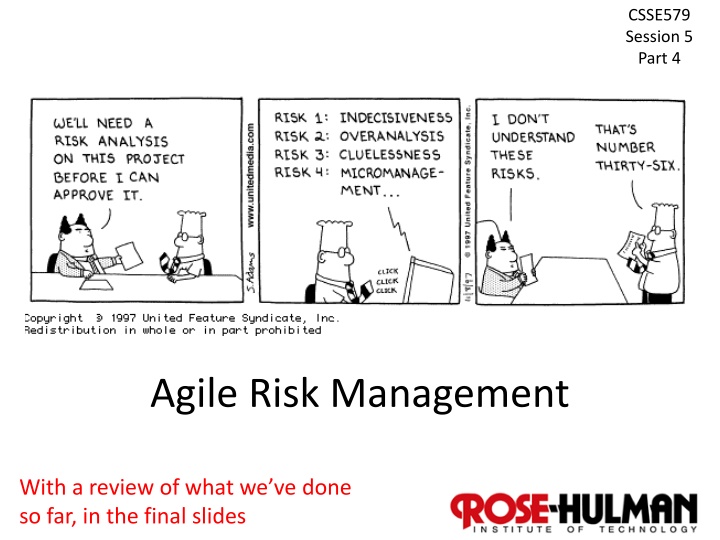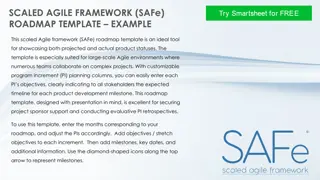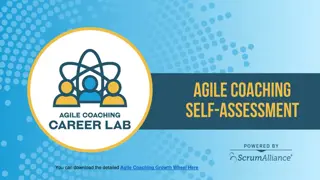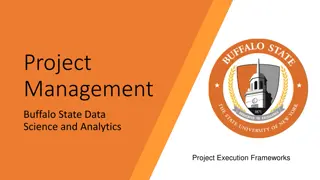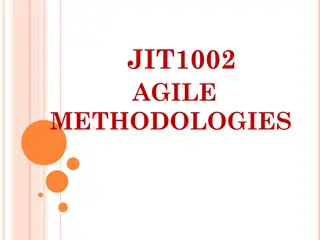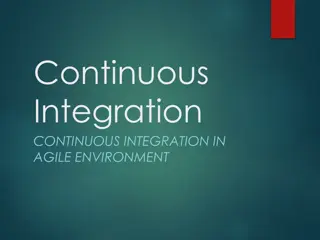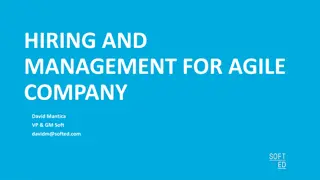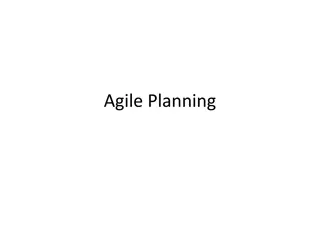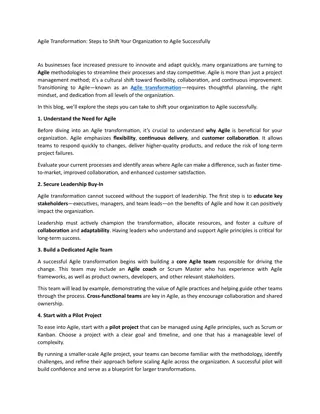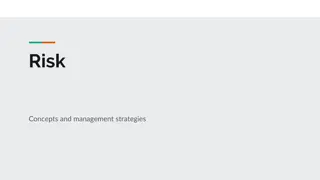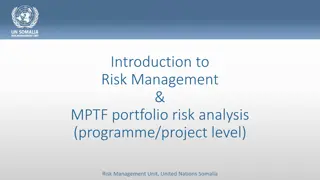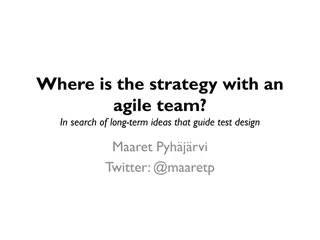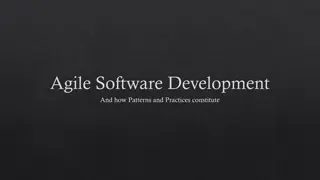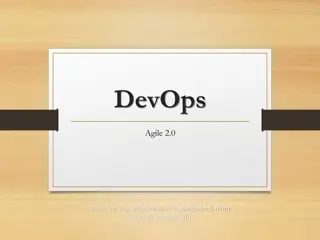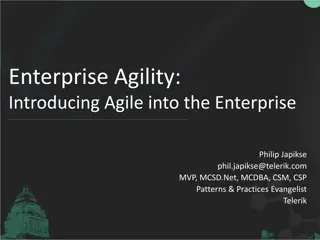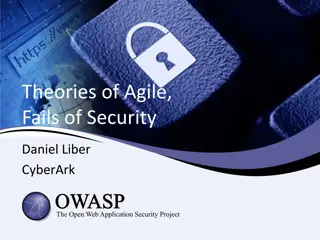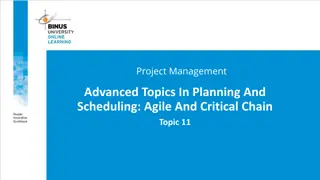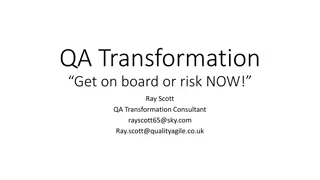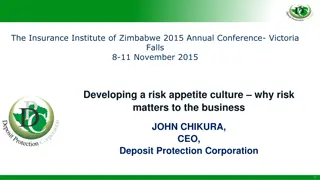Agile Risk Management
In Agile Risk Management, it's crucial to identify potential risks, estimate their impact, and take preventive actions to avoid disruptions. Common sources of risk include personnel shortfalls, unrealistic schedules, and developing the wrong software functions. Highsmith's remedies suggest strategies like team involvement in planning, early error detection, and addressing feature creep collaboratively. Employee turnover can be mitigated through collaboration and cross-training. Effective risk management in Agile projects requires a proactive approach to minimize potential challenges.
Download Presentation

Please find below an Image/Link to download the presentation.
The content on the website is provided AS IS for your information and personal use only. It may not be sold, licensed, or shared on other websites without obtaining consent from the author.If you encounter any issues during the download, it is possible that the publisher has removed the file from their server.
You are allowed to download the files provided on this website for personal or commercial use, subject to the condition that they are used lawfully. All files are the property of their respective owners.
The content on the website is provided AS IS for your information and personal use only. It may not be sold, licensed, or shared on other websites without obtaining consent from the author.
E N D
Presentation Transcript
CSSE579 Session 5 Part 4 Agile Risk Management With a review of what we ve done so far, in the final slides 1
Ok, not rocket science here Figure out what problems you might have Estimate how problematic they would be and likely they are to happen If they are more problematic than makes you feel comfortable (i.e. if they exceed your Risk Referent ) then do something about them Obviously it s better if your process prevents risks rather than simply planning for extra time BUT even that s better than walking off a cliff The difficult part is: Knowing what s at risk Preventing it from being a problem 2
Philips Frequent Sources of Risk 1. Personnel shortfalls 2. Unrealistic schedules and budgets 3. Developing the wrong software functions 4. Developing the wrong user interface 5. Goldplating (paying to much attention to what the customer wants changed) 6. Continuing steam of requirements changes 7. Shortfalls in externally furnished components 8. Real-time performance shortfalls 9. Straining computer science capabilities 3
Highsmiths Sources of Risk These are from DeMarco s book (2003): 1. Inherent schedule flaws 2. Requirements inflation (creep) 3. Employee turnover 4. Specifications breakdown 5. Poor productivity 4
1. Highsmiths remedies for schedule risk Team involvement in planning and estimating Early feedback on delivery velocity Constant pressure to balance the number and depth of features with capacity constraints Close interaction between engineering and customer teams Early error detection/correction to keep a clean working product 5
2. And for feature creep It s not creep, it s growth. Needs to be a joint effort, not features added indiscriminately. Highsmith says, Not as dangerous as he looks 6
3. Employee turnover? Better in agile projects: More collaboration Pair programming Higher morale To ameliorate, Highsmith recommends: Cross-training and Documentation! This one s really two problems people leaving and people arriving. 7
4. Specification breakdown? APM insists on a product manager. They need to resolve spec conflicts. Aided by an executive sponsor They claim tha this should work, somehow. 8
5. Poor productivity? Agile emphasizes getting the right people on the team, to begin with. The fast iterations drive productivity. Agile Riding the plasma wave 9
Leadership required How to be visionary and positive, while Also being brutally honest about risks Denial leads to surprise But constant attention to risk is demoralizing 10
Better and worse with agile Short planning and delivery iterations: Reduced risk of losing customer involvement Less up-front wasted time from project changes But also can have major rework due to oversights Scope oscillation is a problem from hurried customer interaction Increased cost of frequent changes 11
Highsmith argues its new work Can t be made risk-free No one knows for sure if it can be built to spec In the next iteration, go ahead and make these into a single tool 12
Additional tips from Techwell article Risk management in agile is inferred rather than explicit, but Standup meetings are designed to air risks. Retrospectives provide another opportunity. Sizing-up a sprint exposes risks. The responsibility to spot risks should be shared across the team. 13
A good idea for agile? (part 2) Risk burndown chart 15
Our learning outcomes Re-repeated 1. 2. 3. 4. 5. 6. 7. 8. 9. 10. Project management and requirements Wk 4 11. Project management and design 12. Project management and testing Key principles of agile project management Wk 1 Agile software life cycle processes Wk 1 & 2 Agile software project estimation Wk 4 Software risk planning and management Wk 5 Agile software project planning Wk 3 Managing software projects to a plan - Wk 5 Forming and managing project teams Progress, Program/Portfolio Management Wk 6 Adv. Topics: Earned Value, Critical Chain Wk 4 Things I added! 16
Some specific topics / skills to learn! Re-repeated Within the above framework of outcomes Understand program management concepts and strategic goals. Wk 6 Create and maintain software plans and schedules. Wk 5 Select a software life cycle model and methodology to include traditional and agile concepts. Wk 2 Develop software cost estimates and proposals. Wk 4 More 17
Some specific topics / skills to learn! Re-repeated Build, develop, and maintain a software team, including: Acquire the software staff. Build a team communication plan and "run" rules. Assign responsibilities for all functional / team areas. Wk 5 Arrange for training for the software team. Negotiate involvement of all project groups in the software activities. Plan for staff transitions. More 18
Some specific topics / skills to learn! Re-repeated Identify software risk and develop risk management plans. Wk 5 Special topics to consider: Software maintenance versus development. Earned value management. Wk 4 Configuration management. Wk 2 Planning for continuous integration and automation. Project measurements. Wk 5 Ethical decision making. New trends. So, what are your priorities for weeks 7, 8, 9, and 10? 19
